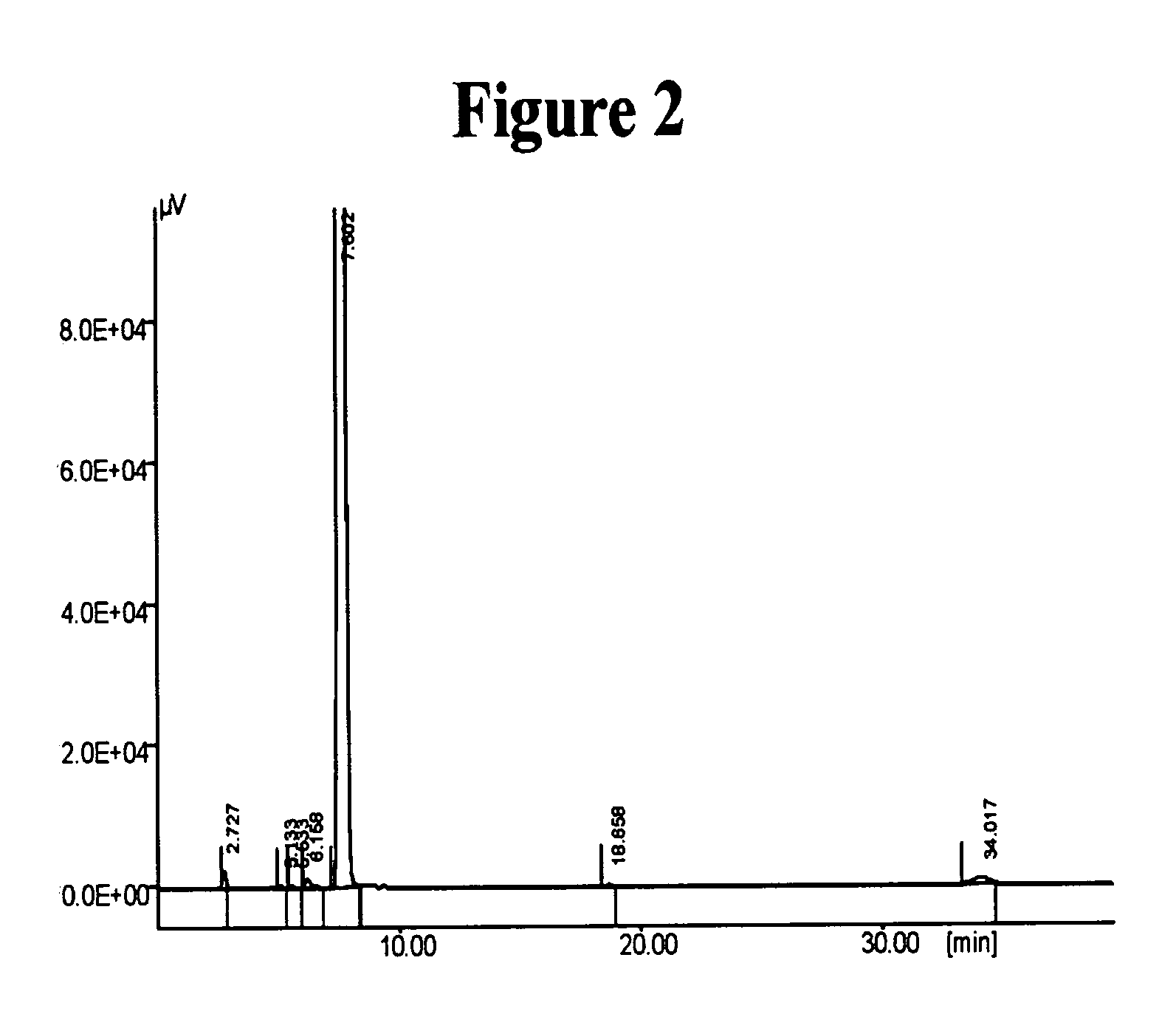Highly pure cilostazol and an improved process for obtaining same
a technology of cilostazol and a process, applied in the field of chemistry, can solve the problems of insufficient blood supply to the leg muscles, severe pain, aching or cramping in the legs, and impair the ability to walk without considerable discomfort, and achieve the effect of high efficiency, cost-effectiveness and simple operation
- Summary
- Abstract
- Description
- Claims
- Application Information
AI Technical Summary
Benefits of technology
Problems solved by technology
Method used
Image
Examples
reference example 1
U.S. Pat. No. 4,277,479 (Examples 4 and 26)
[0166] The preparation of Cilostazol in the presence of 1,8-diazabicyclo[5,4,0]undec-7-ene (DBU) was carried out according to Examples 4 and 26 of U.S. Pat. No. 4,277,479.
[0167] 3.22 grams of 6-hydroxy-3,4-dihydroquinolin-2(1H)one (Compound I, 0.0195 mole) and 3.51 ml of DBU (0.0230 mole) were mixed in 100 ml of ethanol, and the mixture was heated to reflux. A solution of 5.17 grams of 5-(4-chlorobutyl)-1-cyclohexyl-1H-tetrazole (Compound II, 0.0211 mole), in 100ml ethanol was added dropwise over a time period of 90 minutes to the mixture containing Compound I and DBU. The reaction mixture was heated to reflux for 5 additional hours and concentrated thereafter by evaporation under vacuum. Fifty ml of water were added to the concentrated residue, and the mixture was stirred for 3 hours. The formed precipitate was collected by filtration, washed with water and dried at 50° C. overnight to afford 4.78 grams of crude product at 61.3% yield.
[...
reference example 2
(Nishi et al.)
[0171] The preparation of Cilostazol in the presence of potassium hydroxide in 2-propanol was carried out according to Nishi, T. et al., Chem. Pharm. Bull., 1983, 31, pp. 1151-57.
[0172] 16.3 grams of 6-hydroxy-3,4-dihydroquinolin-2(1H)-one (Compound I, 0.98 mole) and 7 grams of flaked potassium hydroxide (0.112 mole) were mixed in 100 ml of 2-propanol, and the mixture was heated to reflux A solution of 28.5 grams of 5-(4-chlorobutyl)-1-cyclohexyl-1H-tetrazole (Compound II, 0.116 mole), in 75 ml 2-propanol was added dropwise over a time period of 45 minutes. to the mixture containing Compound I and potassium hydroxide. The reaction mixture was heated to reflux for 5 additional hours and concentrated thereafter by evaporation under vacuum. The concentrated residue was extracted with chloroform, and the extract was washed successively with 1N NaOH, diluted HCl and water, and dried thereafter over Na2SO4. The chloroform was removed under vacuum, and the residue was dried...
reference example 3
U.S. Pat. Nos. 6,515,128(Example 1) and 6,825,214 Example 1)
[0176] The preparation of Cilostazol using a phase transfer catalyst was carried out according to Example 1 in both U.S. Pat. Nos. 6,515,128 and 6,825,214.
[0177] A mixture of 22.22 grams of 5-(4-chlorobutyl)-1-cyclohexyl-1H-tetrazole (Compound II, 0.0915 mole), 17 grams of Na2SO4 and 1.9 grams of the catalyst Aliquate®336, stirred in 15 ml toluene, was added to a 90 ml aqueous solution containing 16.5 grams of 6-hydroxy-3,4-dihydroquiolin-2(1H)-one (Compound I, 0.1011 mole) and one equivalent of NaOH. The mixture was heated to reflux for 8 hours, and cooled thereafter to room temperature. The solid precipitant was filtered, washed with water and methanol to afford 29 grams of crude product at 85.8% yield.
[0178] HPLC analysis, performed as described above, of the crude product showed a composition of 99.49% of the desired Cilostazol and 0.25% of the impurity Compound III.
[0179] The 29 grams of the crude product were furt...
PUM
| Property | Measurement | Unit |
|---|---|---|
| temperature | aaaaa | aaaaa |
| weight percent | aaaaa | aaaaa |
| weight percent | aaaaa | aaaaa |
Abstract
Description
Claims
Application Information
 Login to View More
Login to View More - R&D
- Intellectual Property
- Life Sciences
- Materials
- Tech Scout
- Unparalleled Data Quality
- Higher Quality Content
- 60% Fewer Hallucinations
Browse by: Latest US Patents, China's latest patents, Technical Efficacy Thesaurus, Application Domain, Technology Topic, Popular Technical Reports.
© 2025 PatSnap. All rights reserved.Legal|Privacy policy|Modern Slavery Act Transparency Statement|Sitemap|About US| Contact US: help@patsnap.com



